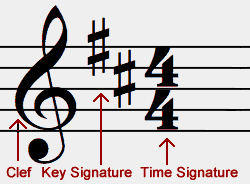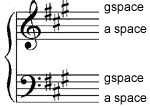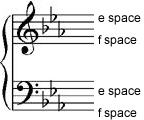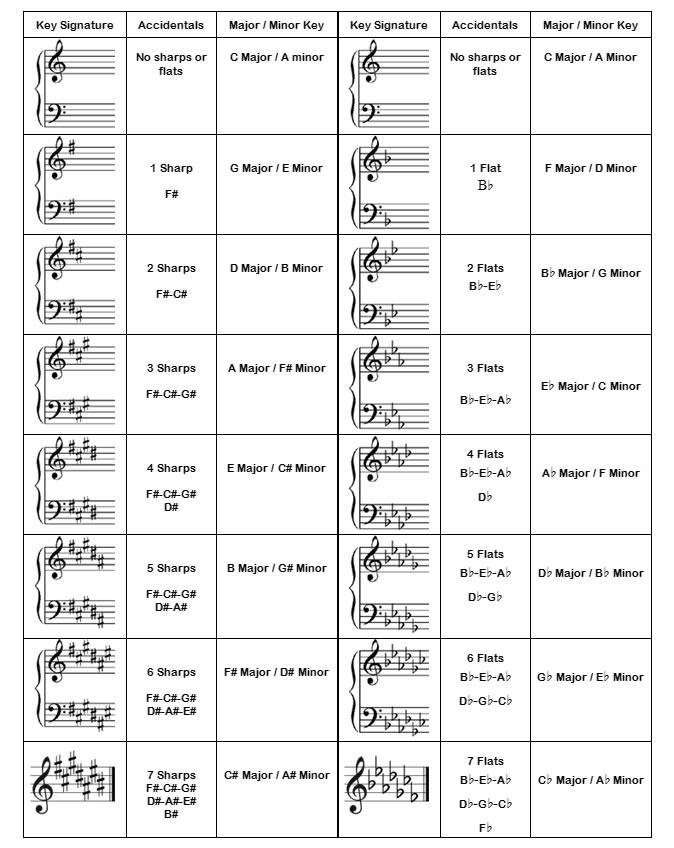Key Signature
The Stave is not alone!A key signature is a collection of sharps or flats placed at the beginning of each Staff (or Stave) in a piece of music. It indicates the tonal center of the composition, showing which notes are consistently altered throughout. By doing so, the key signature tells us what key we are in and helps musicians read and perform the music accurately.
At the beginning of every piece of music, there are 3 pieces of information:
🔹 Clef
🔹 Key Signature
🔹 Time Signature.
The Key Signature is always placed between the Clef and the Time Signature. In the absence of a time signature, it is always placed directly after the clef.

This particular key signature has 2 sharps: F# and C#. The purpose of this is to tell the musician that every time an F or C note is played, it must be F# and C#.
You can't mix up sharps and flats in a key signature. It exhibits either sharps, flats or no accidentals at all, in which case the music is in the key of C Major or A Minor.
To understand key signatures fully, it is good to know about major and minor scales and how they are constructed.
Why Scales Matter for Key Signatures
- A key signature tells us which notes are consistently sharpened or flattened in a piece.
- Those accidentals come directly from the interval pattern of the scale (major or minor) that defines the key.
- Without knowing how scales are built, a key signature is just a set of symbols — the scale explains why those symbols are there.
Key Signatures - Why?
Without them, there could be 'utter chaos' on the Stave especially if you are playing a piece with a lot of sharps or flats in quick time. The following examples will help to illustrate this.
Fig.1
In this example, the piece is in B Major which consists of 5 sharps F# - C# - G# - D# - A#. Every time one of these 5 notes is played, it has to have a sharp in front of it, as there isn't a Key Signature at the beginning of the piece to tell us otherwise.
Fig.2
In this example, the piece is still in B Major but has a Key Signature. It fixes the correct pitch of each note within the piece. If there is an F# in the Key Signature, every time you play an F in the piece, it will be F#. The same applies to the other 4 sharps. (C# - G# - D# - A#)... neat, sweet and complete. Imagine trying to play this piece of music without one!
Order of Sharps and Flats...
Sharps and flats are placed in a particular order on the Music Stave
This order never changes.- The order of sharps is always F# - C# - G# - D# - A# - E# - B# (FCGDAEB)
- The order of flats is always B♭ - E♭ - A♭ - D♭ - G♭ - C♭ - F♭ (BEADGCF)
- Notice that the order of sharps and flats are the exact opposite of one another, e.g., the first sharp is the last flat, the second sharp is the second to last flat etc.
You can make up sayings to help you remember the order where the first letter of each word represents the sharp or flat. You have one saying for the sharps and one saying for the flats:
Order of Sharps: Few Can Gain Distinction And Escape Blame
Order of Flats: By Energy And Diligence Good Children Flourish
Make up your own sayings. The important thing is that you remember them. You will find yourself using them all the time. Here are some others:
Order of Sharps:Father Christmas Gave Dad An Electric Blanket
Fat Cats Go Down Alleys Eating Bats Order of Flats:
Battle Ends and Down Goes Charles Father
Blanket Exploded and Dad Got Cold Feet
Order of Sharps and flats in 1 saying that makes sense: 🥳
Forwards (sharps): Father Charles Goes Down And Ends Battle
Backwards (flats): Battle Ends And Down Goes Charles Father
Accidentals & The Stave
Accidentals are placed on the lines or spaces that they represent within the Stave. Therefore an accidental representing F# would be placed on the F line, an accidental representing C# would be placed in the C space, an accidental representing G# would be placed in the G space etc. The same applies to the flats. (see below).
On a Treble & Bass Clef:
The Sharps are written between the A-space and the G-space

The Flats are written between the F-space and the E-space
Notice that the accidentals always lay within the confines of a Stave. This means they are not placed on any added ledger lines above or below the Stave. (You can see this in the chart below.)
Determining Key Signatures Manually - without the use of charts and aids
Let's say you don't have charts or other aids available. There are other ways...To determine the key signature of any Minor Key, you firstly need to determine the key signature of its relative major key. Also, you need to remember that you start and finish on the Tonic or first note of that particular key, therefore a C Natural Minor Scale will start with a C note and finish with a C note.
Every natural minor key has a relative major key and vice versa - this means they share the same key signature. To determine the major key from a natural minor key simply count up 3 semitones (minor 3rd) from the tonic of the minor key... here are some examples:
- Am + 3 semitones = C Major where the tonic of the minor key is A
- Bm + 3 semitones = D Major
- Cm + 3 semitones = E♭Major
- Dm + 3 semitones = F Major
- Em + 3 semitones = G Major
- Fm + 3 semitones = A♭Major
- Gm + 3 semitones = B♭Major
To determine the natural minor key from a major key simply count down 3 semitones (minor 3rd) from the tonic of the major key... here are some examples:
- C Major - 3 semitones = Am where the tonic of the major key is C.
- D Major - 3 semitones = Bm
- E♭Major - 3 semitones = Cm
- F Major - 3 semitones = Dm
- G Major - 3 semitones = Em
- A♭Major - 3 semitones = Fm
- B♭Major- 3 semitones = Gm
So now we know the major key, we need to determine the key signature - how many sharps or flats are written at the beginning of every Stave, and in what order. We know that C Major and Am are relative to each other and share the same key signature - no sharps or flats... but what about the other keys.
Determining Sharps: Each scale starts on the 5th degree of each previous scale along with an extra sharp in the key signature. To determine whether the 5th degree is a sharp or natural key, simply count up 7 semitones. Remember that each Scale Degree or note must have a different name.
To determine the order of sharps and flats, make up or use one of the many sayings available where the first letter of each word represents the sharp or flat. Here's a good one where the saying incorporates both sharps and flats using the reverse order for flats... this way you only have to remember one saying.
Order Of Sharps: Father Charles Goes Down And Ends Battle ( F#, C#, G#, D#, A#, E#, B#)
Order Of Flats: Battle Ends And Down Goes Charles' Father (B♭, E♭, A♭, D♭, G♭, C♭, F♭)
Lets take C major as our starting point... no sharps or flats
| Degree | Key Signature | Interval |
|---|---|---|
| 5th degree of C Major is G major | 1 sharp – F# | C + 7 semitones = G |
| 5th degree of G Major is D major | 2 sharps – F#, C# | G + 7 semitones = D |
| 5th degree of D Major is A major | 3 sharps – F#, C#, G# | D + 7 semitones = A |
| 5th degree of A Major is E major | 4 sharps – F#, C#, G#, D# | A + 7 semitones = E |
| 5th degree of E Major is B major | 5 sharps – F#, C#, G#, D#, A# | E + 7 semitones = B |
| 5th degree of B Major is F# major | 6 sharps – F#, C#, G#, D#, A#, E# | B + 7 semitones = F# |
| 5th degree of F# Major is C# major | 7 sharps – F#, C#, G#, D#, A#, E#, B# | F# + 7 semitones = C# |
Determining Flats: Each scale starts on the 4th degree of each previous scale along with an extra flat in the key signature. To determine whether the 4th degree is a flat or natural key, simply count up 5 semitones.
Lets take C major as our starting point... (no sharps or flats)
| Degree | Key Signature | Interval |
|---|---|---|
| 4th degree of C Major is F major | 1 flat – B♭ | C + 5 semitones = F |
| 4th degree of F Major is B♭ major | 2 flats – B♭, E♭ | F + 5 semitones = B♭ |
| 4th degree of B♭ Major is E♭ major | 3 flats – B♭, E♭, A♭ | B♭ + 5 semitones = E♭ |
| 4th degree of E♭ Major is A♭ major | 4 flats – B♭, E♭, A♭, D♭ | E♭ + 5 semitones = A♭ |
| 4th degree of A♭ Major is D♭ major | 5 flats – B♭, E♭, A♭, D♭, G♭ | A♭ + 5 semitones = D♭ |
| 4th degree of D♭ Major is G♭ major | 6 flats – B♭, E♭, A♭, D♭, G♭, C♭ | D♭ + 5 semitones = G♭ |
| 4th degree of G♭ Major is C♭ major | 7 flats – B♭, E♭, A♭, D♭, G♭, C♭, F♭ | G♭ + 5 semitones = C♭ |
Key Signatures for all Major & Minor Keys
The following chart shows key signatures for every major and minor key:

Finding a keynote from accidentals in the Key Signature
Finding the keynote from # Sharps:
- In a major key signature with sharps, the last sharp (furthest to the right) is always the leading tone (7th degree) of the scale.
- To find the tonic (keynote), simply go up one semitone from that last sharp.
- This works because the leading tone is always a half‑step below the tonic in major scales.
7th degree to the tonic = 1 semitone

In this example we see 1 sharp - F# after the clef.
If you ascend 1 semi-tone from F#, you
get G... presto!
You are in the key of G Major.
Finding the keynote from ♭ Flats
- In a major key signature with flats, the last flat (furthest to the right) is always the subdominant (4th degree) of the scale.
- To find the tonic (keynote), simply go up a perfect 4th (7 semitones) from that last flat.
- This works because the subdominant is always a perfect fourth below the tonic in major scales.
4th degree to the tonic = 7 semitones.

In this example we see 4 flats - B♭, E♭, A♭, and D♭ after the clef.
If you ascend 7 semitones from D♭ (the last flat), you get A♭.
You are in the key of A♭ Major.
If you see no sharps or flats in the key signature, you are in the key of C Major or A Minor.
